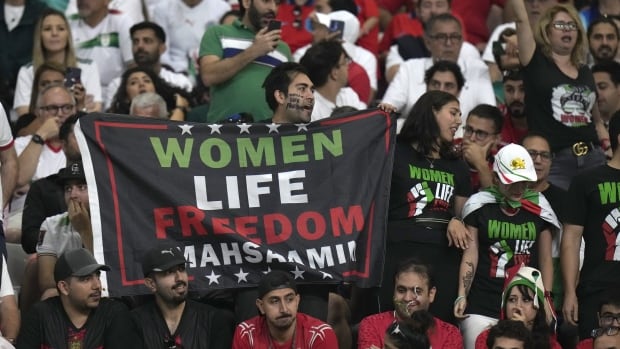The U.S. Soccer Federation briefly displayed Iran’s national flag on social media without the emblem of the Islamic Republic, saying the move supports protesters in Iran ahead of the two nations’ World Cup match on Tuesday.
Iran’s government reacted by accusing the United States of removing the name of God from their national flag.
The decision by the U.S. Soccer Federation, also known as U.S. Soccer, adds yet another political firestorm to the Middle East’s first World Cup, one that organizers had hoped would be spared of off-the-field controversies.
It also comes as the U.S. faces Iran in a decisive World Cup match, which was already freighted by the decades of enmity between the two countries and the nationwide protests now challenging Tehran’s theocratic government.
The U.S. federation said in a statement on Sunday morning that it decided to forgo the official flag on social media accounts to show “support for the women in Iran fighting for basic human rights.”
The Twitter account of the U.S. men’s team displayed a banner with the squad’s matches in the group stage, with the Iranian flag bearing only its green, white and red colours. The same could be seen in a post on its Facebook and Instagram accounts laying out the point totals so far in its group.
By Sunday afternoon, the normal flag with the emblem had been restored in the Twitter banner as attention to it grew.
“We wanted to show our support for the women in Iran with our graphic for 24 hours,” the federation said.
The U.S. federation displayed the official Iranian flag in a graphic showing Group B standings on its website.
The brief absence of the emblem comes as months-long demonstrations have challenged Iran’s government since the Sept. 16 death of 22-year-old Mahsa Amini, who had been detained by the country’s morality police.
At least 450 people have been killed since the protests started, and more than 18,000 have been arrested, according to Human Rights Activists in Iran, an advocacy group following the demonstrations.
Iran has not released casualty or arrest figures for months, and it alleges without providing evidence that the protests have been fomented by its enemies abroad, including the U.S.
Tehran also restricts press access and has detained more than 63 reporters and photographers since the demonstrations began, according to the Committee to Protect Journalists, making covering the unrest that much more difficult.
Iranian media weigh in
Iran’s mission to the United Nations and its soccer federation did not respond to a request for comment from The Associated Press. As comments raged online, Iranian state television described the U.S. federation as “removing the symbol of Allah” from the Iranian flag.
Iran’s semiofficial ISNA news agency quoted Safiollah Fagahanpour, an adviser to the Iranian football federation, saying that the “measures taken regarding the Islamic Republic of Iran flag are against the law” of FIFA competitions.
“They must be held responsible,” Fagahanpour said. “Obviously they want to affect Iran’s performance against the U.S by doing this.”
The Islamic Republic emblem, designed in 1980, is four curves with a sword between them. It represents the Islamic saying: “There is no god but God.” It also resembles a tulip or lotus.
At the top and the bottom of the flag, there are 22 inscriptions of “God is Great,” which honours the date on the Persian calendar when the Islamic Revolution took hold.
The flag has become a point of contention at the World Cup. Apparent pro-government supporters have waved it, shouting at those demonstrating over Amini’s death. Others at matches have waved Iran’s lion and sun flag, an emblem of its former ruler, the late Shah Mohammad Reza Pahlavi.
More security forces could be seen at Iran’s last match against Wales. In the capital Tehran, anti-riot police — the same ones cracking down on protests — waved the Iranian flag after the Wales win, angering demonstrators.


